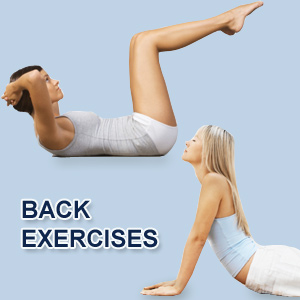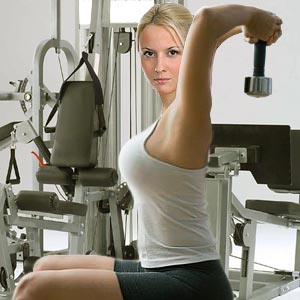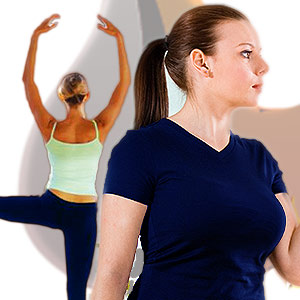Lower Back Exercise

Statistics reveal that almost about 70% of the Americans suffer from some form of back pain at one point in their lives. Back pain is one of the most common work related injuries. It is the second leading cause for missed workdays in the US. It is not that only people who do physically demanding jobs that require heavy lifting are the ones at risk.
Even persons working in front of the computer in the same position all day run a major risk for developing back problems. A man's pillar of strength and vigor is his back, and this fact holds good for a woman as well.
There are specific exercises for the back and lower back that can help relieve the aching. Most exercises concentrate on lower back since it is the most common site for pain. Back is a very sensitive area and performing inadequate improper exercises could have serious consequences. A health care professional need to be consulted before embarking on any form of back exercise or lower back exercises.
Back exercise
Back is supported by the bones of the spine. An intricate system of muscles and ligaments is attached to the spine. They increase the strength and stability of the spine, keep the body upright and support movement. The muscles that support the spine are normally grouped under three categories:
The Extensors which include the back and gluteal muscles are used to straighten the back, help in standing, lift and extend the hip.
The Flexors are the abdominal and iliopsoas muscles that are used to bend and support the spine from the front. They help control the arch of the lumbar lower spine and flex and abduct the hip.
The Obliques or Rotators are paraspinal muscles that are used to stabilize the spine when upright and rotate the spine. They help to maintain proper posture and spinal curvature.
Most instances of back pain are due to soft tissue injury or back muscle strain. Weak and overly tight supporting muscles may cause a person to suffer painful spasms and injuries. The resulting poor posture can aggravate the pain. Back muscles and abdominals do not get adequate exercises from a person's daily activities. Back muscles tend to weaken with age unless they are specifically exercised. A regular back exercise routine helps maintain strong muscles and reduce the likelihood of back pain.
Back exercise regimen
- The back/low back exercise program involves a series of stretching and strengthening exercises. The purpose of these exercises is to improve the flexibility and add strength to the trunk musculature that is so essential for care of the lower back.
- Back exercises need to be performed everyday or at least once in two days. Regular exercise program leads to improvements in the body posture, work endurance and athletic performance.
- Back exercises have to be performed at a slow pace. If there is pain, then it is necessary to immediately stop the exercise and contact the physician immediately.
- The back exercises should be done on a firm but soft surface. It is necessary to use a carpet or a mattress.
General exercises for the back
Knee to chest: Lie on your back on a firm surface with hands clasped behind the thigh. Pull one thigh towards your chest. Keep the opposite leg flat on the surface. Repeat for other leg too.
Pelvic Tilt: Lie on your back on a firm surface. Place the flat on flat surface and bend the knees. Push the small of your back into the floor by pulling the lower abdominal muscles up and in. Hold your back flat while breathing easily in and out. Hold for five seconds.
Hip Rolling: Lie on your back on a firm surface and cross your arms over your chest. Turn your head and trunk to the right while you turn both knees to the left. Allow your knees to relax and go down without forcing. Bring knees back up, head to center. Repeat the exercise in reverse directions.
Pelvic Lift: Lie on your back on a flat surface. Keep your feet flat on the surface and bend the knees. Keep your legs together and cross your arms over your chest. Tilt the pelvis and push your back to the floor then slowly lift your buttocks off the floor as far as possible without straining. Lower your buttocks slowly to the floor.
Curl ups: Lie on your back on a flat surface. Your feet should be flat on the surface with the knees bent. Slowly reach your arms in front of you as much as possible curling your trunk. Keep the neck muscles relaxed and breathe normally. Slowly return to starting position.
Cat and Camel: Kneel down on the floor. Assume 'all fours' position. Keep your head straight so that the gaze of your eyes is towards the floor. Slowly let your trunk sag thereby arching the back. Then round your back up at the waist as far as you can by contracting your lower abdominal muscles as you lower the top of your head towards the floor. All the above motions should be initiated from your lower back.
Tail wagging: Kneel on a mat and assume the 'all fours' position. Keep your head in a neutral position by looking down at the floor. Keeping your shoulders still, move your right hip toward your right shoulder as far as you can. Slowly return to the starting position. Then move your left hip towards your left shoulder as far as you can.
Back extension: Lie on your stomach on a mat and place your arms at your sides so that they are by your hips. Raise your head and shoulders off the mat as comfortably high as possible. Lower the head and shoulders. Do not tense the shoulder muscles.
Push up: Lying on your stomach place your hands, palms down on the floor at the level of your shoulders. Flex your toes so that the weight of your body is shared by your hands and soles of your feet. Pushing with your arms raise your trunk and legs off the floor. Keep your back straight and do not let your stomach sag. Bend your elbows to lower your body halfway toward the floor. Then push your body back by straightening your arms.
Backward Bending: Stand up straight with your feet shoulder width apart. Keep your knees as straight as possible. Place your hands on your back firmly at your waist level. Bend backwards at your waist keeping the knees as straight as possible. Return slowly to the upright position.
Exercise program for healing back pain
The exercises for back pain need to be done in a controlled, gradual and progressive manner. The right exercise can aid in better distribution of nutrients in the disk space and healthy muscles and ligaments. Generally back pain exercise program consists of a combination of stretching exercises such as hamstring stretching, strengthening exercises such as dynamic lumbar stabilization exercise, low impact aerobics such as walking, bicycling, water therapy and swimming.
Low back pain exercises
Ankle pumps: Lie on your back and move your ankles up and down.
Heel slides: Lie on your back and slowly bend and straighten the knee.
Abdominal contraction: Lie on your back with knees bent and hands resting below ribs. Tighten abdominal muscles to squeeze ribs down toward back. Be sure not to hold breath.
Heel raises: Stand with weight even on both feet. Slowly raise heels up and down.
Straight leg raises: Lie on your back with one leg straight and one knee bent. Tighten abdominal muscles to stabilize low back. Slowly lift leg straight up about 6 to 12 inches and hold 1 to 5 seconds. Lower leg slowly.
Piriformis stretch: Lie on your back. Bend one knee and cross the other leg on it. Pull opposite knee to chest until a stretch is felt on the buttock and hip area. Hold on for 20 seconds and then relax.
Many inherent health benefits can be derived from regular routine exercise walking. For people with ongoing back pain, balanced and stable walking maintains and enhances the ability to continue with daily routine and reducing the likelihood of severe episodes of back pain. Walking increases the stability of the spine and conditions the muscles in the feet, legs, hips and torso and help keep the body in an upright position.
Walking for exercise facilitates strong circulation and nourishes the spinal structures. A carefully planned and executed exercise regimen for back and lower back can do much to alleviate the pain and aid in the healing process, while at the same time preventing future problems.
Top of the Page: Lower Back Exercise
Tags:#back exercise #lower back exercise

Posture Correction
Qigong Exercises
Five Tibetan Rites
Piloxing Workout
Calisthenics
Karate For Women
Self Defense for Women
Krav Maga
Circuit Training
Interval Training
Hybrid Workouts
Barre Workout
Eskrima Workout
Learn Tai Chi
Indoor Rock Climbing
Reducing Body Fat Percentage
Fat Burning Zone
PACE Progressively Accelerating Cardiopulmonary Exertion
Non-exercise Activity Thermogenesis
Women Fitness
Morning Exercise and Metabolism
Choosing Fitness Center
Fitness Center for Women
Fitness Weight Loss in women
Home Fitness Equipment
Kid Fitness
Gym Safety Tips
Building Lean Muscle
Lose Belly Fat
Flat Belly Tips
Exercises for Women

Toned Arms for Females
Hip Flexor Strengthening
How to lose Muffin Top
Plyometric Exercises
Flexibility Exercise Program
Belly Bloat
Body Sculpting Exercises
Core Strengthening Exercises
Core Strengthening Benefits
Exercise for Seniors
Fitness Exercise Articles
Anti Aging Exercise
Rebounder Exercise
Jogging Exercise
Flat Stomach Exercise
Knee Exercise
Butt Exercise
Weight Exercises for Women
Chest Exercise for Women
Stretching Exercise
Lower Back Exercise
Hip Exercises
Leg Exercise
Abdominal Exercise
Face Workout
Face Exercises Benefits
Double Chin Exercise
Eye Exercise Benefit
Thigh Exercises
Stair Climbing Exercise
Isometric Exercise
Pilates Exercise
Magic Circle Exercises
Rotator Cuff Exercises
Arm Exercise
Kegel Exercises for Women
Carpal Tunnel Exercises
Exercise Equipment
Xiser Workout
Foam Rolling Exercises
Rowing Exercise Machine
Elliptical Machine Benefits
Stepper Exercise Machine
Dumbbell Exercise
Weight Loss Calculator
Strapless Heart Rate Monitor
Home Exercise Equipment
Recumbent Exercise Bike
Resistance Exercise Band
Weight Lifting Exercise
Ball Exercise
Kettlebell Exercises
Medicine Ball Exercises
Swiss Exercise Ball
Kamagon Ball Workouts
Top of the Page: Lower Back Exercise
Popularity Index: 101,468

